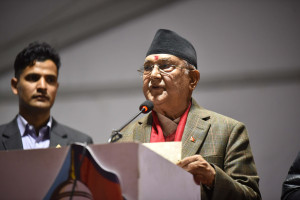Editorial
Forever hungry
Producing and distributing nutritious food should be a political priority
Last month, Sabita Nepali, a severely malnourished eight-month old infant had to be rushed to the local health centre after her health deteriorated. She is among the 1500 children under the age of five who are acutely malnourished in Bajhang—a remote district in the far western region. According to a recent report published by the Ministry of Agricultural Development (MoAD) and World Food Programme (WFP), most districts in the often neglected region like Achham, Doti, Baitadi are all food stressed areas while there is almost a crisis situation in Bajura.
According to the Global Food Security Index 2017, Nepal is 81st most food insecure country in the world. Although Nepal has the potential to be self-sufficient in food and even export it—more than 60 percent of the population is dependent on agriculture—our country is hobbled by the lack of appropriate policies to facilitate the use of quality farm inputs and technology.
Food security is an important development and political issue across the world, but far more so for a country like ours where the level of hunger is still worrying. Nepal experienced rapid improvements in reducing hunger and is nearing the ‘moderate’ from the ‘serious’ category, largely due to declines in undernourishment, child stunting, and child mortality. The population of undernourished people stood at 8.1 percent according to the 2014-2016 Global Hunger Index Report. Nonetheless, there are deep inequalities within the country when it comes to food and alleviating hunger.
Our dependence on development agencies to curb hunger-related issues is one of the main reasons why food security is a perennial problem. Organisation like the World Food Program has been operating in the country since 1963. Supporting food security and nutrition remain among its major objectives, but even after 55 years of serving in the country and spending billions of dollars, not a whole lot has changed. Perhaps, the fact that the organisation provides food supplies only after a crisis emerges—their approach, and mandate, is to react—is why the problem has been enduring.
Food insecurity and malnutrition are closely linked. The government has introduced basic interventions to address these challenges. The Agriculture Development Strategy and Multi-sector Nutrition Plan (2013-2017) was particularly formulated to reduce chronic malnutrition in the country. Similarly, the Nepal Food Security Monitoring System is considered as a comprehensive food security monitoring and analysis system at national and district level that collects analyses and presents information on household food security, emerging crises, markets, and nutrition across the country. These efforts have been successful to some extent, but the government needs to concentrate on a long-term plan that addresses the root causes of food insecurity. And that includes moving away from excessive reliance on development partners alone to tackle issues like this.
Instead, the government should focus on introducing sustainable farming systems. Our microclimatic variations allow us to grow various kinds of crops and vegetables. The government’s No. 1 priority should be to increase production of crops so that all households have access to adequate food.
The availability of, and access to, domestically produced food is a key issue affecting basic survival, nutrition, national security, and stability. Producing and distributing nutritious food as a public health measure should be a politicalpriority. Until the policymakers do not realise this, Nepal’s dream of ending hunger and achieving food security will remain a pipedream—and children like Sabita will continue to suffer.




 8.12°C Kathmandu
8.12°C Kathmandu














